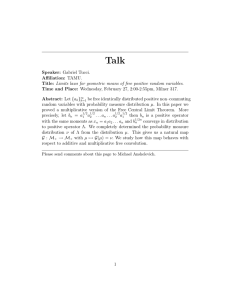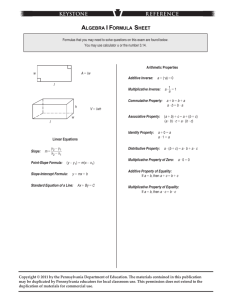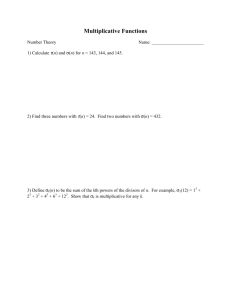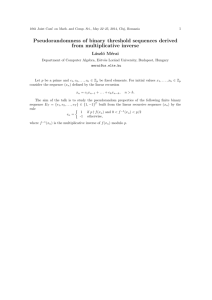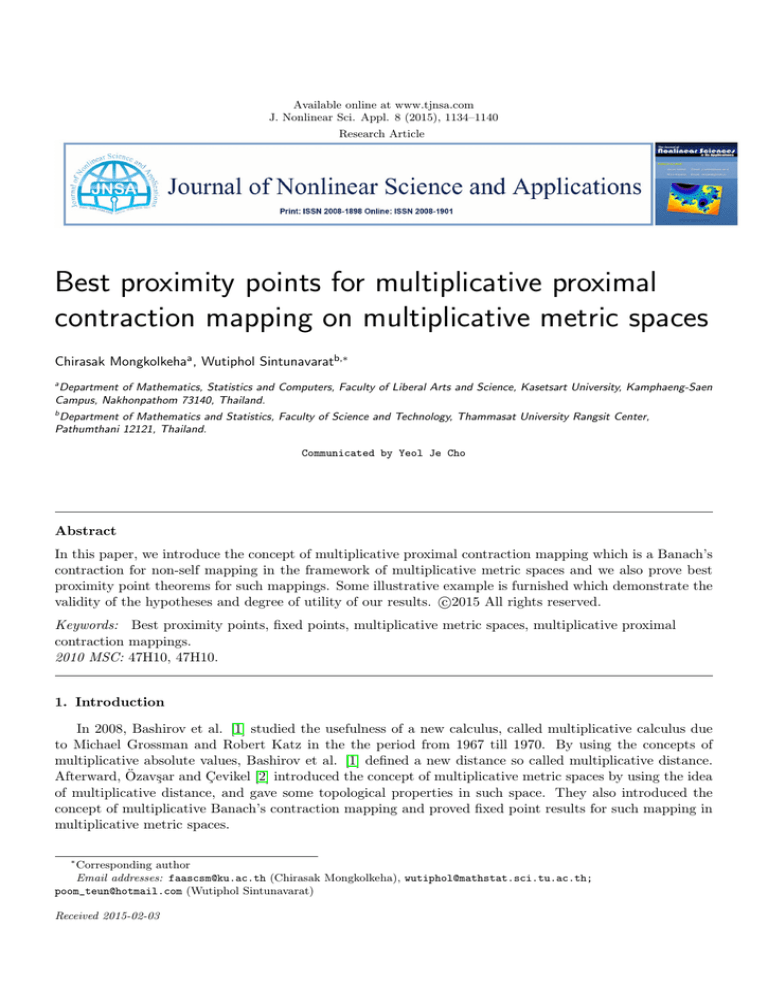
Available online at www.tjnsa.com
J. Nonlinear Sci. Appl. 8 (2015), 1134–1140
Research Article
Best proximity points for multiplicative proximal
contraction mapping on multiplicative metric spaces
Chirasak Mongkolkehaa , Wutiphol Sintunavaratb,∗
a
Department of Mathematics, Statistics and Computers, Faculty of Liberal Arts and Science, Kasetsart University, Kamphaeng-Saen
Campus, Nakhonpathom 73140, Thailand.
b
Department of Mathematics and Statistics, Faculty of Science and Technology, Thammasat University Rangsit Center,
Pathumthani 12121, Thailand.
Communicated by Yeol Je Cho
Abstract
In this paper, we introduce the concept of multiplicative proximal contraction mapping which is a Banach’s
contraction for non-self mapping in the framework of multiplicative metric spaces and we also prove best
proximity point theorems for such mappings. Some illustrative example is furnished which demonstrate the
c
validity of the hypotheses and degree of utility of our results. 2015
All rights reserved.
Keywords: Best proximity points, fixed points, multiplicative metric spaces, multiplicative proximal
contraction mappings.
2010 MSC: 47H10, 47H10.
1. Introduction
In 2008, Bashirov et al. [1] studied the usefulness of a new calculus, called multiplicative calculus due
to Michael Grossman and Robert Katz in the the period from 1967 till 1970. By using the concepts of
multiplicative absolute values, Bashirov et al. [1] defined a new distance so called multiplicative distance.
Afterward, Özavşar and Çevikel [2] introduced the concept of multiplicative metric spaces by using the idea
of multiplicative distance, and gave some topological properties in such space. They also introduced the
concept of multiplicative Banach’s contraction mapping and proved fixed point results for such mapping in
multiplicative metric spaces.
∗
Corresponding author
Email addresses: faascsm@ku.ac.th (Chirasak Mongkolkeha), wutiphol@mathstat.sci.tu.ac.th;
poom_teun@hotmail.com (Wutiphol Sintunavarat)
Received 2015-02-03
C. Mongkolkeha, W. Sintunavarat, J. Nonlinear Sci. Appl. 8 (2015), 1134–1140
1135
The aim of this paper is to introduce the new classes of proximal contractions which are more general
than class of multiplicative Banach’s contraction for non-self mapping. We also give the necessary condition
to have best proximity points and give some illustrative example of our main results. Our main results
generalize, extend and improve the corresponding results on the topics given in the literature.
2. Preliminaries
In this section, we give some definitions and basic concept of multiplicative metric space for our consideration. Throughout this paper, we denote by N, R+ and R the sets of positive integers, positive real
numbers and real numbers, respectively.
Definition 2.1 ([1]). Let X be a nonempty set. A mapping d : X × X → R is said to be a multiplicative
metric if it satisfying the following conditions:
(m1) d(x, y) ≥ 1 for all x, y ∈ X and d(x, y) = 1 if and only if x = y,
(m2) d(x, y) = d(y, x) for all x, y ∈ X
(m3) d(x, z) ≤ d(x, y) · d(y, z) for all x, y, z ∈ X (multiplicative triangle inequality).
Also, the ordered pair (X, d) is called multiplicative metric space.
Example 2.2 ([2]). Let d∗ : (R+ )n × (R+ )n → R be defined as follows
∗ ∗
∗
x1 x2 xn ∗
d (x, y) = · · · · ,
y1
y2
yn
where x = (x1 , x2 , . . . , xn ), y = (y1 , y2 , . . . , yn ) ∈ (R+ )n and | · |∗ : R+ → R+ is defined as follows
a if a ≥ 1,
∗
|a| =
1
if a < 1.
a
Then ((R+ )n , d∗ ) is a multiplicative metric space.
The following notations and results given by Özavşar and Çevikel [2].
Definition 2.3 ([2]). Let (X, d) be a multiplicative metric space, x ∈ X and ε > 1. Define the following
set:
Bε (x) := {y ∈ X : d(x, y) < ε},
which is called the multiplicative open ball of radius ε with center x.
Similarly, one can describe the multiplicative closed ball as follows:
B ε (x) := {y ∈ X : d(x, y) ≤ ε}.
Definition 2.4 ([2]). Let (X, d) be a multiplicative metric space, {xn } be a sequence in X and x ∈ X.
If, for any multiplicative open ball Bε (x), there exists a natural number N such that, for all n ≥ N ,
xn ∈ Bε (x), then the sequence {xn } is said to be multiplicative convergent to the point x, which is denoted
by xn →∗ x as n → ∞.
Lemma 2.5 ([2]). Let (X, d) be a multiplicative metric space, {xn } be a sequence in X and x ∈ X. Then
xn →∗ x as n → ∞ if and only if d(xn , x) →∗ 1 as n → ∞.
Lemma 2.6 ([2]). Let (X, d) be a multiplicative metric space and {xn } be a sequence in X. If the sequence
{xn } is multiplicative convergent, then the multiplicative limit point is unique.
Definition 2.7 ([2]). Let (X, d) be a multiplicative metric space and {xn } be a sequence in X. The sequence
{xn } is called a multiplicative Cauchy sequence if, for all ε > 1, there exists N ∈ N such that d(xm , xn ) < ε
for all m, n ≥ N .
C. Mongkolkeha, W. Sintunavarat, J. Nonlinear Sci. Appl. 8 (2015), 1134–1140
1136
Lemma 2.8 ([2]). Let (X, d) be a multiplicative metric space and {xn } be a sequence in X. Then {xn } is
a multiplicative Cauchy sequence if and only if d(xn , xm ) →∗ 1 as m, n → ∞.
Theorem 2.9 ([2]). Let (X, d) be a multiplicative metric space. Let {xn } and {yn } be two sequences in X
such that xn →∗ x ∈ X and yn →∗ y ∈ X as n → ∞. Then d(xn , yn ) →∗ (x, y) as n → ∞.
Definition 2.10 ([2]). Let (X, d) be a multiplicative metric space and A ⊆ X. Then we call x ∈ A, a
multiplicative interior point of A if there exists an ε >1 such that Bε (x) ⊆ A. The collection of all interior
points of A is called multiplicative interior of A and denoted by int(A).
Definition 2.11 ([2]). Let (X, d) be a multiplicative metric space and A ⊆ X. If every point of A is a
multiplicative interior point of A, i.e., A = int(A), then A is called a multiplicative open set.
Definition 2.12 ([2]). Let (X, d) be a multiplicative metric space. A subset S ⊆ X is called multiplicative
closed in (X, d) if S contains all of its multiplicative limit points.
Theorem 2.13 ([2]). Let (X, d) be a multiplicative metric space. A subset S ⊆ X is multiplicative closed if
and only if X \ S, the complement of S, is multiplicative open.
Theorem 2.14 ([2]). Let (X, d) be a multiplicative metric space and S ⊆ X. Then the set S is multiplicative
closed if and only if every multiplicative convergent sequence in S has a multiplicative limit point that belongs
to S.
Theorem 2.15 ([2]). Let (X, d) be a multiplicative metric space and S ⊆ X. Then (S, d) is complete if and
only if S is multiplicative closed.
Theorem 2.16 ([2]). Let (X, dX ) and (Y, dY ) be two multiplicative metric spaces, f : X → Y be a mapping
and {xn } be any sequence in X. Then f is multiplicative continuous at the point x ∈ X if and only if
f (xn ) →∗ f (x) as n → ∞ for every sequence {xn } with xn →∗ x as n → ∞.
Next, we give the notations A0 , B0 and d(A, B) for nonempty subsets A and B of a multiplicative metric
space (X, d) in the same sense in metric spaces.
Let A and B be nonempty subsets of a multiplicative metric space (X, d), we recall the following notations
and notions that will be used in what follows.
d(A, B) := inf{d(x, y) : x ∈ A and y ∈ B},
A0 := {x ∈ A : d(x, y) = d(A, B) for some y ∈ B},
B0 := {y ∈ B : d(x, y) = d(A, B) for some x ∈ A}.
Definition 2.17. Let A be nonempty subset of a multiplicative metric space (X, d). A mapping g : A → A
is said to be isometry if d(gx, gy) = d(x, y) for all x, y ∈ A.
Definition 2.18. Let A and B be nonempty subsets of a multiplicative metric space (X, d). A point x ∈ A
is called a best proximity point of a mapping T : A → B if it satisfies the condition that d(x, T x) = d(A, B).
It can be observed that a best proximity reduces to a fixed point if the underlying mapping is a selfmapping.
Definition 2.19. A subset A of a multiplicative metric space (X, d) is said to be approximatively compact
with respect to B if every sequence {xn } in A satisfies the condition that d(y, xn ) →∗ d(y, A) as n → ∞ for
some y ∈ B has a convergent subsequence.
We observe that each set is approximatively compact with respect to itself.
C. Mongkolkeha, W. Sintunavarat, J. Nonlinear Sci. Appl. 8 (2015), 1134–1140
1137
3. Main Result
In this section, we introduce the new class of proximal contractions in the framework of multiplicative
metric spaces so called multiplicative proximal contraction mappings and prove best proximity theorems for
mappings in such class on multiplicative metric spaces.
Definition 3.1. Let A and B be nonempty subsets of a multiplicative metric space (X, d). A mapping
T : A → B is called a multiplicative proximal contraction if there exists α ∈ [0, 1) satisfying the following
condition:
for u, v, x, y ∈ A,
d(u, T x) = d(A, B),
=⇒ d(u, v) ≤ d(x, y)α .
d(v, T y) = d(A, B)
It is easy to see that a self-mapping that is a multiplicative proximal contraction is precisely a Banach’s
contraction which is due to Özavşar and Çevikel [2]. However, a nonself-proximal contraction mapping is
not necessarily a Banach’s contraction mapping.
Theorem 3.2. Let (X, d) be a complete multiplicative metric space and A, B be nonempty closed subsets
of X such that A0 and B0 are nonempty and B is approximatively compact with respect to A. Suppose that
T : A → B and g : A → A satisfy the following conditions:
(a) T is a multiplicative proximal contraction;
(b) T (A0 ) ⊆ B0 ;
(c) g is an isometry;
(d) A0 ⊆ g(A0 ).
Then there exists a unique point x∗ ∈ A such that
d(gx∗ , T x∗ ) = d(A, B).
Moreover, for any fixed x0 ∈ A0 , the sequence {xn } defined by
d(gxn , T xn−1 ) = d(A, B)
converges to the element x∗ .
Proof. Let x0 be a fixed element in A0 . In view of the fact that T (A0 ) ⊆ B0 and A0 ⊆ g(A0 ), there exists
an element x1 ∈ A0 such that
d(gx1 , T x0 ) = d(A, B).
Since T (A0 ) ⊆ B0 and A0 ⊆ g(A0 ), there exists an element x2 ∈ A0 such that
d(gx2 , T x1 ) = d(A, B).
Since T is a multiplicative proximal contraction and g is isometry, we get
d(x2 , x1 ) = d(gx2 , gx1 )
≤ d(x1 , x0 )α .
Again, since T (A0 ) ⊆ B0 and A0 ⊆ g(A0 ), there exists an element x3 ∈ A0 such that
d(gx3 , T x2 ) = d(A, B).
(3.1)
C. Mongkolkeha, W. Sintunavarat, J. Nonlinear Sci. Appl. 8 (2015), 1134–1140
1138
It follows from T is a multiplicative proximal contraction, g is an isometry and (3.1) that
d(x3 , x2 ) = d(gx3 , gx2 )
≤ d(x2 , x1 )α
2
≤ d(x1 , x0 )α .
By the same method, for each n ∈ N, we can find xn , xn+1 ∈ A0 such that
d(gxn , T xn−1 ) = d(A, B)
and
d(gxn+1 , T xn ) = d(A, B).
(3.2)
This implies that
d(xn+1 , xn ) = d(gxn+1 , gxn )
≤ d(xn , xn−1 )α
2
≤ d(xn−1 , xn−2 )α
..
.
≤ d(x1 , x0 )α
n
for all n ∈ N. Next, we will show that {xn } is a Cauchy sequence. Let m, n ∈ N with m > n, then we get
d(xm , xn ) ≤ d(xm , xm−1 ) · d(xm−1 , xm−2 ) · · · d(xn+1 , xn )
m−1
m−2
n
≤ d(x1 , x0 )α
· d(x1 , x0 )α
· · · d(x1 , x0 )α
m−1 +αm−2 +···+αn
= d(x1 , x0 )α
αn
≤ d(x1 , x0 ) 1−α .
Taking m, n → ∞ in the above inequality, we obtain that d(xm , xn ) →∗ 1. Hence {xn } is a Cauchy sequence.
Since A is a closed subsets of complete multiplicative metric space X, then the sequence {xn } converges to
some element x ∈ A. Notice that,
d(gx, B) ≤
≤
=
≤
d(gx, T xn )
d(gx, gxn+1 ) · d(gxn+1 , T xn )
d(gx, gxn+1 ) · d(A, B)
d(gx, gxn+1 ) · d(gx, B)
for all n ∈ N. Since, g is continuous and the sequence {xn } converges to x, then the sequence {gxn }
converges to gx, that is d(gx, gxn ) →∗ 1 as n → ∞. Therefore, d(gx, T xn ) →∗ d(gx, B) as n → ∞. Since
B is approximatively compact with respect to A, then there exists subsequence {T xnk } of sequence {T xn }
such that converging to some element u ∈ B. Further, for each k ∈ N, we have
d(A, B) ≤ d(gx, u)
≤ d(gx, gxnk +1 ) · d(gxnk +1 , T xnk ) · d(T xnk , u)
= d(gx, gxnk +1 ) · d(A, B) · d(T xnk , u).
(3.3)
Letting k → ∞ in (3.3), we get d(gx, u) = d(A, B) and hence gx ∈ A0 . From the fact that A0 ⊆ g(A0 ), then
gx = gz for some z ∈ A0 . By the isometry of g, we get
d(x, z) = d(gx, gz) = 1
and thus x = z, that is, x is an element of A0 . Since, T (A0 ) ⊆ B0 , then there exists x∗ ∈ A such that
d(x∗ , T x) = d(A, B).
(3.4)
C. Mongkolkeha, W. Sintunavarat, J. Nonlinear Sci. Appl. 8 (2015), 1134–1140
1139
From (3.2), (3.4) and the multiplicative proximal contractive condition of T , we have
d(gxn+1 , x∗ ) ≤ d(xn , x)α
for all n ∈ N. This yields that
lim d(gxn+1 , x∗ ) ≤ lim d(xn , x)α = 1α = 1.
n→∞
n→∞
(3.5)
This shows that the sequence {gxn } converges to x∗ . By Lemma 2.6, we get that gx = x∗ . Hence,
d(gx, T x) = d(x∗ , T x) = d(A, B).
Next, to prove the uniqueness, suppose that there exist x? ∈ A with x 6= x? and
d(gx? , T x? ) = d(A, B).
Since g is an isometry and T is a multiplicative proximal contraction, it follows that
d(x, x? ) = d(gx, gx? ) ≤ d(x, x? )α ,
which is a contradiction. Therefore, we get x = x? . This completes the proof.
If g is the identity mapping in Theorem 3.2, then we obtain the best proximity point results as follows:
Corollary 3.3. Let (X, d) be a complete multiplicative metric space and A, B be nonempty closed subsets of
X such that A0 and B0 are nonempty and B is approximatively compact with respect to A. Let T : A → B
satisfies the following conditions:
(a) T is a multiplicative proximal contraction;
(b) T (A0 ) ⊆ B0 .
Then there exists a unique point x∗ ∈ A such that
d(x∗ , T x∗ ) = d(A, B).
Moreover, for any fixed x0 ∈ A0 , the sequence {xn } defined by
d(xn , T xn−1 ) = d(A, B)
converges to the element x∗ .
For a self-mapping, Theorem 3.2 contains the following result:
Corollary 3.4 ([2]). Let (X, d) be a complete multiplicative metric space and let T : X → X be a multiplicative Banach’s contraction, then T has a unique fixed point.
Next, we give an example to illustrate Theorem 3.2.
Example 3.5. Let X = R2 . Define the mapping d : X × X → R by
d((x1 , x2 ), (y1 , y2 )) = e|x1 −y1 |+|x2 −y2 |
for all (x1 , x2 ), (y1 , y2 ) ∈ X. It is easy to see that (X, d) is a complete multiplicative metric space. Let
A = {(0, x) : x ∈ R}
and
B = {(1, y) : y ∈ R}.
C. Mongkolkeha, W. Sintunavarat, J. Nonlinear Sci. Appl. 8 (2015), 1134–1140
1140
Then d(A, B) = e, A0 = A, B0 = B and B is approximatively compact with respect to A. Define two
mappings T : A → B and g : A → A as follows:
x
T ((0, x)) = 1, ) and g((0, x)) = (0, −x)
2
for all (0, x) ∈ A. For all (0, x), (0, y) ∈ A, we get
d(g(0, x), g(0, y)) = d((0, −x), (0, −y)) = e|−x+y| = e|x−y| = d((0, x), (0, y)).
This implies that g is an isometry.
Next, we show that T is a multiplicative proximal contraction with α = 12 . Let (0, u), (0, v), (0, x) and
(0, y) be elements in A satisfying
d(g(0, u), T (0, x)) = d(A, B) = e,
Then we have u = −
d(g(0, v), T (0, y)) = d(A, B) = e.
y
x
and v = − and hence
2
2
d(g(0, u), g(0, v)) = d((0, −u), (0, −v))
x
y
= d 0, , 0,
2
2
1
=
e|x−y|
=
1
d((0, x), (0, y))) 2 .
2
This implies that T is a multiplicative proximal contraction with α = 21 . Now all hypotheses in Theorem 3.2
hold and so there exists a unique point x∗ in A such that d(gx∗ , T x∗ ) = d(A, B). In this case, x∗ = (0, 0) ∈ A
is a unique element such that
d(gx∗ , T x∗ ) = d(g(0, 0), T (0, 0)) = d((0, 0), (1, 0)) = e = d(A, B).
4. Conclusions
Best proximity point results for multiplicative proximal contraction mapping in multiplicative metric
spaces along with approximatively compactness was investigated under some suitable conditions. These
result are a generalization of fixed point result for multiplicative Banach’s contraction self-mappings due to
Özavşar and Çevikel [2]. However, the best proximity point results for mappings satisfies another proximal
contractive conditions in multiplicative metric spaces still open for interested mathematicians.
Acknowledgements
The first author would like to thank Department of Mathematics statistics and computers, Faculty of
Liberal Arts and Science, Kasetsart University, and also the Kasetsart University Research and Development
Institute (KURDI) for financial support in this work. The second author gratefully acknowledge the financial
support provided by Thammasat University under the government budget 2015, Contract No. 014/2558.
References
[1] A. E. Bashirov, E. M. Kurpinar, A. Özyapici, Multiplicative calculus and its applications, J. Math. Anal. Appl.,
337 (2008), 36–48. 1, 2.1
[2] M. Özavşar, A. C. Çevikel, Fixed points of multiplicative contraction mappings on multiplicative metric spaces,
arXiv, 2012 (2012), 14 pages. 1, 2.2, 2, 2.3, 2.4, 2.5, 2.6, 2.7, 2.8, 2.9, 2.10, 2.11, 2.12, 2.13, 2.14, 2.15, 2.16, 3,
3.4, 4



